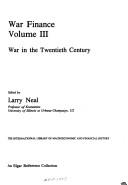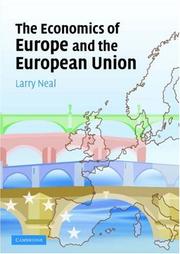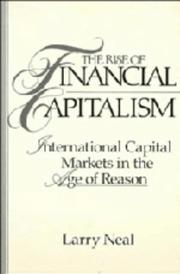| Listing 1 - 10 of 35 | << page >> |
Sort by
|
Multi
ISBN: 9781107034174 9781107621213 9781139524858 Year: 2015 Publisher: Cambridge Cambridge University Press
Abstract | Keywords | Export | Availability | Bookmark
 Loading...
Loading...Choose an application
- Reference Manager
- EndNote
- RefWorks (Direct export to RefWorks)
World history --- Economics --- International finance --- History.

ISBN: 1852786639 Year: 1994 Volume: 12 Publisher: London Elgar
Abstract | Keywords | Export | Availability | Bookmark
 Loading...
Loading...Choose an application
- Reference Manager
- EndNote
- RefWorks (Direct export to RefWorks)
War finance --- Finances de guerre --- History --- Histoire --- Finances de guerreHistory
Book
ISBN: 0300153163 9786613601223 0300153171 1280571624 9780300153170 9780300153163 Year: 2012 Publisher: New Haven Yale University Press
Abstract | Keywords | Export | Availability | Bookmark
 Loading...
Loading...Choose an application
- Reference Manager
- EndNote
- RefWorks (Direct export to RefWorks)
Two of the greatest financial fiascos of all time took place at the same time and were instigated by two acquaintances: the Mississippi Bubble, on which John Law at first made a vast fortune and gained sway over French finances; and the South Sea Bubble, launched by Law and Thomas Pitt, Jr., Lord Londonderry, his main partner in England. This book tells the story of these two financial schemes from the letters and accounts of two leading personalities. Larry Neal, a distinguished economic historian, highlights the rationality of each person and also finds that the primitive exchanges of the day, though informal and completely unregulated, actually performed reasonably well.
Business cycles -- History -- 18th century. --- Financial crises -- History -- 18th century. --- Law, John, -- 1671-1729. --- South Sea Company. --- Business cycles --- Financial crises --- Finance --- Business & Economics --- Investment & Speculation --- History --- Law, John, --- Crashes, Financial --- Crises, Financial --- Financial crashes --- Financial panics --- Panics (Finance) --- Stock exchange crashes --- Stock market panics --- Economic cycles --- Economic fluctuations --- Law, --- Law, Jan, --- Compagnie du Sud --- Company of Merchants Trading to the South Seas --- Governour and Company of Merchants of Great Britain Trading to the South Seas and Other Parts of America, and for Encouraging the Fishery --- Crises --- Cycles --- Company of Merchants of Great Britain Trading to the South Seas and Other Parts of America, and for Encouraging the Fishery --- Economic schools --- Law, John

ISBN: 9780521683012 9780521864510 0521683017 0521864518 9780511754142 9780511649073 051164907X 9780511273230 0511273231 9780511274022 0511274025 0511754140 9780511271618 0511271611 9780511573231 0511573235 1107713951 Year: 2007 Publisher: Cambridge New York Cambridge University Press
Abstract | Keywords | Export | Availability | Bookmark
 Loading...
Loading...Choose an application
- Reference Manager
- EndNote
- RefWorks (Direct export to RefWorks)
This distinctive textbook combines comprehensive coverage of the key policy areas of the European Union with analysis of individual countries, including the recent accession countries and Turkey. Part I analyzes the economic bases for the rise of the European Union from its origins in the post-World War II recovery to its historic enlargement in 2004. Part II takes up the different nation-state perspectives on the EU's economic policies by looking in turn at all European countries, whether members of the EU or not. The book is unique in providing both an EU perspective and European nation-state perspective on the major policy issues which have arisen since the end of World War II, as well as putting the economic analysis into an historical narrative which emphasizes the responses of policy-makers to external shocks such as the Cold War, the oil shocks, German reunification, and the collapse of the Soviet Union.
330.940559
---
BPB0801
---
339.92

ISBN: 052138205X 0521457386 0511665121 9780521382052 9780511665127 9780521457385 Year: 1990 Publisher: Cambridge: Cambridge university press,
Abstract | Keywords | Export | Availability | Bookmark
 Loading...
Loading...Choose an application
- Reference Manager
- EndNote
- RefWorks (Direct export to RefWorks)
This work establishes the existence of a sophisticated and smoothly functioning system of financial markets in the mercantile states of northwestern Europe throughout the 1700s. Based on computer analysis of thousands of price quotes from the financial press of the eighteenth century, the results should force both historians and economists to re-evaluate their understanding of the evolution of financial markets and their importance for the economic developments of that era.
World history --- anno 1700-1799 --- 331.161.1 --- Geschiedenis van het overheidskrediet en van de overheidsschuld. --- Capital market --- International finance --- History. --- History --- Marché financier --- Finances internationales --- Histoire --- Great Britain --- Netherlands --- Capital market - Great Britain - History. --- Capital market - Netherlands - History. --- International finance - History. --- 331.13 --- 331.162.1 --- AA / International- internationaal --- Capital markets --- Market, Capital --- Finance --- Financial institutions --- Loans --- Money market --- Securities --- Crowding out (Economics) --- Efficient market theory --- Geschiedenis van de handel --- Geschiedenis van het overheidskrediet en van de overheidsschuld --- Geschiedenis van de financiële markten --- Arts and Humanities --- Capital market - Great Britain - History --- Capital market - Netherlands - History --- International finance - History --- marche international des capitaux --- internationale kapitaalmarkt
Book
ISBN: 1316446859 1139524852 1316443841 1107034175 1107621216 9781316443842 9781316446850 9781139524858 Year: 2015 Publisher: Cambridge, England : Cambridge University Press,
Abstract | Keywords | Export | Availability | Bookmark
 Loading...
Loading...Choose an application
- Reference Manager
- EndNote
- RefWorks (Direct export to RefWorks)
Ever since the financial crisis of 2008, doubts have been raised about the future of capitalism. In this broad-ranging survey of financial capitalism from antiquity to the present, Larry Neal reveals the ways in which the financial innovations throughout history have increased trade and prosperity as well as improving standards of living. These innovations have, however, all too often led to financial crises as a result of the failure of effective coordination among banks, capital markets, and governments. The book examines this key interrelationship between financial innovation, government regulation and financial crises across three thousand years, showing through past successes and failures the key factors that underpin any successful recovery and sustain economic growth. The result is both an essential introduction to financial capitalism and also a series of workable solutions that will help both to preserve the gains we have already achieved and to mitigate the dangers of future crises.
International finance --- International Finance --- Finance --- Business & Economics --- History --- History.
Book
Year: 2002 Publisher: Cambridge, Mass. National Bureau of Economic Research
Abstract | Keywords | Export | Availability | Bookmark
 Loading...
Loading...Choose an application
- Reference Manager
- EndNote
- RefWorks (Direct export to RefWorks)
Book
Year: 2006 Publisher: Wien ONB
Abstract | Keywords | Export | Availability | Bookmark
 Loading...
Loading...Choose an application
- Reference Manager
- EndNote
- RefWorks (Direct export to RefWorks)
Book
ISBN: 3031562771 Year: 2024 Publisher: Cham : Springer Nature Switzerland : Imprint: Palgrave Macmillan,
Abstract | Keywords | Export | Availability | Bookmark
 Loading...
Loading...Choose an application
- Reference Manager
- EndNote
- RefWorks (Direct export to RefWorks)
“The Louisiana Purchase is mostly remembered for the political acumen of Thomas Jefferson and Napoleon’s pragmatism. This book shows that the grand bargain to double the size of the US depended on the financial engineering of two European merchant bankers. The bankers initiated a deal that avoided confrontation between the US and France and circumvented Britain’s opposition. Perhaps this is why Jefferson stated that banks “are more dangerous than standing armies.” – Rui Esteves, Professor, Geneva Graduate Institute “When Napoleon in 1803 offered to sell France’s territorial claims in North America, the young United States did not have the money to buy. But it had something equally important: credit in the world of international finance. Neal’s splendid contribution to financial history reveals how two enterprising European bankers used U.S. creditworthiness to structure the deal and arrange the financing that allowed the United States to double its territory and become a rising global power.” – Richard Sylla, New York University “A complete reversal of what we thought we knew about the Louisiana purchase. As Professor Neal shows in this tour de maître, the financiers who masterminded the purchase did not ‘arrange it’. They were really the puppeteers of the whole act." – Marc Flandreau, Howard S. Marks Professor of Economic History at University of Pennsylvania This book provides a comprehensive account of how the Louisiana Purchase of 1803 was financed. Where existing research has focused predominantly on the political and diplomatic significance of the Purchase, this book focuses on the ‘forgotten financiers’ of the Purchase – individuals from the US, France and the UK including Alexander Baring, Albert Gallatin, Pierre Cesar Labouchere and François Barbè-Marbois. Larry Neal is Emeritus Professor of Economics at the University of Illinois at Urbana-Champaign, Research Associate of the National Bureau of Economic Research, and Fellow of the Cliometrics Society. .
Louisiana Purchase. --- International finance --- Louisiana Purchase --- History --- History. --- Finance. --- Economic history. --- International finance. --- Economics. --- Financial History. --- Economic History. --- International Finance. --- Political Economy and Economic Systems.
Article
Abstract | Keywords | Export | Availability | Bookmark
 Loading...
Loading...Choose an application
- Reference Manager
- EndNote
- RefWorks (Direct export to RefWorks)
| Listing 1 - 10 of 35 | << page >> |
Sort by
|

 Search
Search Feedback
Feedback About UniCat
About UniCat  Help
Help News
News